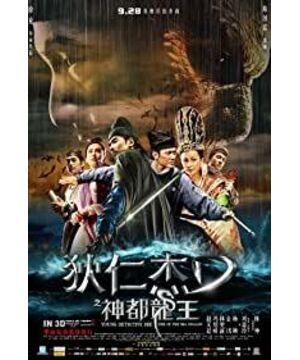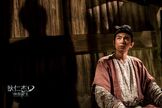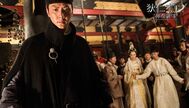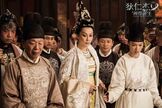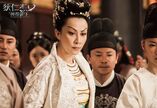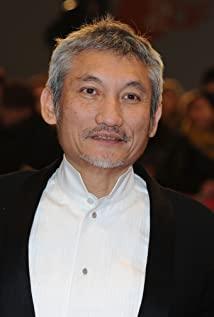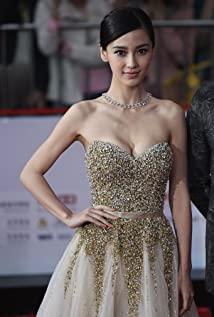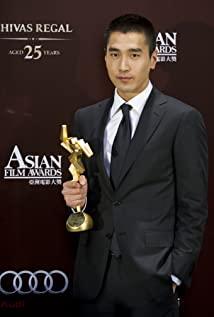First question: After watching this movie, what did you see?
I'll answer myself, it's a costume film in a detective's coat, interspersed with Japanese monster films (Godzilla), ninja films (Ninja), weird stories (Haunted), Thai-style Gu films, Universal monster films (Black Lake Demon Tan), Iron Man (breaking through the roof), and even the shadow of a fairy tale movie (Beauty and the Beast); to be specific, it is "Journey to the West" + "Pirates of the Caribbean" + "Naruto" + "Superman Diga"... ... wow, a fly, a great value.
This is exactly the handwriting of the old monster Xu Kexu.
In the field of ancient costume martial arts films alone, Tsui Hark has produced a number of film series, such as the famous "Shushan" series, the trend-leading "A Chinese Ghost Story" series, the "Eastern Invincible" series of chasing stars and chasing the moon, and the peak of the "Yellow Mountain" series. Fei Hong" series and so on (ah, he accidentally exposed his childhood), the world view of his films is completely different, the concept of action design is also completely different, and the behind-the-scenes collaborators are even more different. Even "Seven Swords", according to some interview materials, Xu Keben also intends to expand the series, but it is difficult to achieve due to many reasons. Therefore, "Dragon King of Shendu" not only has the difference between the young Di Renjie and the middle-aged Di Renjie, but also Wu Zetian and Sha Tuozhong who run through the two parts. It is also Tsui Hark, Chen Guofu, Zhang Jialu and Shi Nansheng who cooperate in many ways to integrate into the history of ancient costumes. , detective martial arts, strange stories, monsters, ninja monsters and other elements, relying on computer special effects, integrating traditional martial arts actions, and jointly create another set of 3D masterpieces.
We don’t need to investigate whether there is a sea in the periphery of Luoyang, whether the Turkic Xianbei Fuyu East Island appears so complete at the same time, and the characters fight out of gravity, etc., because these bugs already exist in “Empire of Tongtian”. In "Empire of Tongtian", the 66-foot-long Tongtian Buddha and the incredible underground ghost market, Tsui Hark loves exaggerated performances, strange doors, strange powers, and unrestrained imagination. In his vision, Luoyang City is such a row upon row of faces, with hidden dragons and crouching tigers, and people from ten continents in the market - so in "Dragon King of Shendu", it seems so familiar.
But no matter how reckless he is, there are some established historical facts about characters that Tsui Hark has not changed. This is like Huang Feihong, Fang Shiyu, Hong Xiguan, and even Ye Wen. No matter how they are adapted and shaped, they all have their own people. They are people-oriented, and they use their personal destiny to penetrate the hatred of the country and the family. When Tsui Hark chose Di Renjie from the official history, this can also be interpreted as that he put aside the martial arts novels of Zhuanzhu Zhuzhu, Jin Yong and Liang Yusheng in the past, and entered a new creative environment. This breakthrough is even further than his previous works - in the film we see the appearance of a stick actor, and the creative team also has the participation of the Korean team.
It is true that the story and characters of "Dragon King of Shendu" are not comparable to that of "Empire of Heaven" (except for AB), the plot is neither good-looking nor faulty, just plain and mediocre, and there is no desire to catch bugs. Not to mention the relative decline of the protagonists. The tone of "Dragon King of Shendu" is slightly relaxed, the suspenseful color is weakened, and the layout is more precise, which reduces the overall difficulty of solving the case, and is more like an adventure to the ocean. The simplest comparison, in "Empire of Tongtian", Shangguan Jinger, Pei Donglai, Sha Tuozhong died successively, the Buddha collapsed, the atmosphere was bleak, and the dialogue was solemn and sad. In "Dragon King of Shendu", the rejuvenation of the actors brings a bright tone, which is very youthful. But those funny dialogues and slightly revealed basic feelings are not necessarily a wise move in the narrative of the story; Once again, Chen Jianhao's style is dull, the characters are incompatible without sparks, and the character is too flat; white horses treading the sea or something doesn't necessarily add much points...
In fact, 3D movies are to watch 3D special effects. You don't need to use it every time to make deep and big truths. But in fact, looking at Tsui Hark's works and the vast majority of Hong Kong films, commercial entertainment is always given the top priority - not everyone wants to be a people's artist who is both virtuous and artistic. The most exciting cliff fighting scene in "Dragon King of Shendu", with spectacle and design; the climax of the sea monster slaying, scenes and stunts, a contest, the audience only cares about the victory, the loss and the casualty, in fact, they have little impact on the relationship between the characters . The "Dragon King of Shendu" presented in front of the audience is fun enough, fierce enough, novel enough to stimulate gorgeousness, weirdness, evil spirits and demonic spirits, which is enough for me.
View more about Young Detective Dee: Rise of the Sea Dragon reviews


